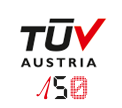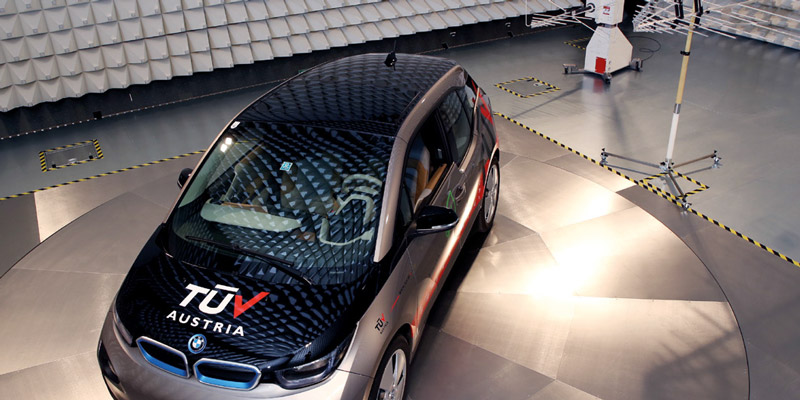Electromagnetic compatibility in focus
- 06/20/2016
- Industry & Energy
- Created by Mario Wasserfaller
Cell phone, dishwasher or car: where current flows electromagnetic radiation will also be emitted. To ensure that individual components and equipment do not disrupt or cripple each other, electromagnetic compatibility (EMC) is tested on the test bench in the new TÜV AUSTRIA EMC anechoic chamber in Vienna before series production, which is primarily intended to meet the increasing demands of the automotive industry.
The testing and certification provider has been performing EMC measurements for more than 20 years, says Wilhelm Seier, who is responsible for telecommunications and EMC at TÜV AUSTRIA. Through the ever larger proportion of electronic components this has resulted in an increasing demand, of not just being able to evaluate components but rather whole vehicles. Due to intensified pressure for innovation and constantly new specifications, even large manufacturers from the automotive sector through to suppliers do not always have the means to perform such measurements themselves.
Electric and electronic devices fundamentally emit electromagnetic fields, but can also be effected by external fields. "When it comes to impairments, product functionality may no longer be guaranteed", according to Seier. This may be critical where the security of people is at risk, from ABS systems in cars through to pacemakers. So in-house EMC guidelines are also part of the CE label, with which it is clarified that the product corresponds to all applicable EU regulations.
Complete separation from the environment
"In order to measure the EMC properties of a product, i.e. the radiation that is emitted into open space, the specimen has to be separated from the environment", Seier explains regarding the requirements for the construction of the new "multifunctional EMC
measurement and testing chamber for the assessment of radiated emission and immunity properties of equipment, systems and components". This separation from various external sources of interference – such as (mobile) communications, radio and television waves – is guaranteed by the implementation of a metallic shielded structure. In order to measure in compliance with standards, the walls and ceiling must be clad with absorbent materials, which reduce a reflection of the emissions so far that they no longer deliver a measurable contribution. This requirement is implemented by a pyramid absorber, which is applied over ferrite material ("SEMI-ANECHOIC CHAMBER").
In accordance with the requirements, the test chamber is generously and flexibly constructed with an area of 15 by 12 meters and a height of 6.5 meters: the central element is a six meter diameter revolving disc with a possible total load of eight tonnes. It can accommodate not only a whole vehicle for analysis, but also industrial facilities. The test objects are introduced via a sliding door with a small opening size of three by three meters.
This procedure itself can stretch across several hours. "The test object is rotated 360 degrees, the height and polarization of a measuring antenna is varied and this process is observed across the frequency range to be assessed", Seier describes the usual measuring setup with the non-human "test objects". Because when it comes to checking the electromagnetic exposure of people (electromagnetic compatibility of environment, EMVU), clearly a shielded environment is no longer needed, but instead measured on-site, for example the high-frequency field strength of telecommunications Transmitters.
Extract from the applicable standards
- EN 55011 Industrial, scientific and medical equipment – Radio frequency disturbance characteristics – Limits and methods of measurement
- EN 55014 Electromagnetic compatibility – Requirements for household appliances, electric tools and similar apparatus
- EN 55022 Information technology equipment – Radio disturbance characteristics – Limits and methods of measurement
- EN 55032 Electromagnetic compatibility of multimedia equipment – Emissions requirements
- EN 61000-4-3 Electromagnetic compatibility (EMC) – Part 4.3 Testing and measurement techniques – Radiated, radio-frequency electromagnetic field immunity to interference
- CISPR 25 Vehicles, boats and internal combustion engines – Radio disturbance characteristics – Limits and methods of measurement for the protection of on-board receivers
- ISO 11451-2 Road vehicles – Vehicle test methods for electrical disturbances from narrowband radiated electromagnetic energy
- ISO 11452-2 Road vehicles – Component test methods for electrical disturbances from narrowband radiated electromagnetic energy
- RTCA DO-160G Environmental Conditions and Test Procedures for Airborne Equipment
- MIL-STD-461F Requirements for the control of electromagnetic interference characteristics of subsystems an equipment
Elektromagnetische Verträglichkeit (EMV) auf dem Prüfstand. Dies geschieht in der neuen EMV-Prüfhalle des TÜV AUSTRIA in Wien, (C) TÜV AUSTRIA, Andreas Amsüss

